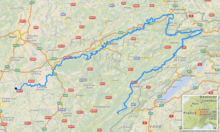|
Doubs (river)
The Doubs (/duː/ doo; French: [du] ⓘ; Arpitan: Dubs; German: Dub (obsolete)) is a 453-kilometre (281 mi) river in far eastern France which strays into western Switzerland. It is a left-bank tributary of the Saône.[1] It rises near Mouthe in the western Jura mountains, at 946 metres (3,104 ft) and its mouth is at Verdun-sur-le-Doubs, a village and commune in Saône-et-Loire at about 175 m (574 ft) above sea level. It is the tenth-longest river in France. The most populous settlement of the basin lies on its banks, Besançon. Its course includes a small waterfall and a 4-kilometre (2.5 mi) narrow lake. CourseFrom its source in Mouthe it flows northeast: a few kilometers north of the French-Swiss border, then to form the border for less distance, about 40 km. North of the Swiss town of Saint-Ursanne it turns west then southwest. South-east of Montbéliard it adopts a southwest striation or fault of the Jura Mountains, flowing so over greater distance than the flow it has traced before. It then flows into the Saône at Verdun-sur-le-Doubs about 20 km (12 mi) northeast of Chalon-sur-Saône. The shape of the course resembles the silhouette of a terrier sitting upright, leaning right, with the upper part of a northeastern corner "ear" the only zone in Switzerland, there reaching Saint-Ursanne. In that country it borders or crosses the cantons Jura and Neuchâtel. Waterfalls and lakeThe falls known as the Saut du Doubs is on the French-Swiss border. Nearby, the river, dammed up by landslide debris, forms the 4-kilometre (2.5 mi) long, 200-metre (660 ft) wide, winding lake, (le) Lac des Brenets. The 27-metre (89 ft)-high Doubs Falls are at the lake's end. The falls can be reached on foot or by passenger boat.[2]   The Doubs flows through the following Departments of France, Cantons of Switzerland, and cities:
Tributaries include:[1] The river forms several lakes:
 Floods and seasonal variationThe rate of flow of the Doubs is very seasonally variable. The flooding or well-watered season can stretch from September to May, caused by heavy rains or by quick melting of snow from the Jura mountains. At its mouth, the discharge rate can vary from as low as 20 cubic metres per second (710 cu ft/s) to over 1,000 cubic metres per second (35,000 cu ft/s) during floods. In Besançon, the largest floods have been in 1852 (8.5 metres or 27 feet 11 inches), in 1896 (7.96 metres or 26 feet 1 inch) and in 1910. Hydroelectricity As a mountain river with substantial discharge, the Doubs has been used for electricity generation. Among several hydroelectric stations, the most important are the Dam of Châtelot, 74 metres (243 ft) tall, and the Dam of Refrain, 66.5 metres (218 ft) tall. In popular cultureThe river is mentioned sixteen times in Stendhal's novel The Red and the Black (Le rouge et le noir). See also
ReferencesWikimedia Commons has media related to Doubs River.
Information related to Doubs (river) |
||||||||||||||||||||||||||||||||||||||||||||||||||||

